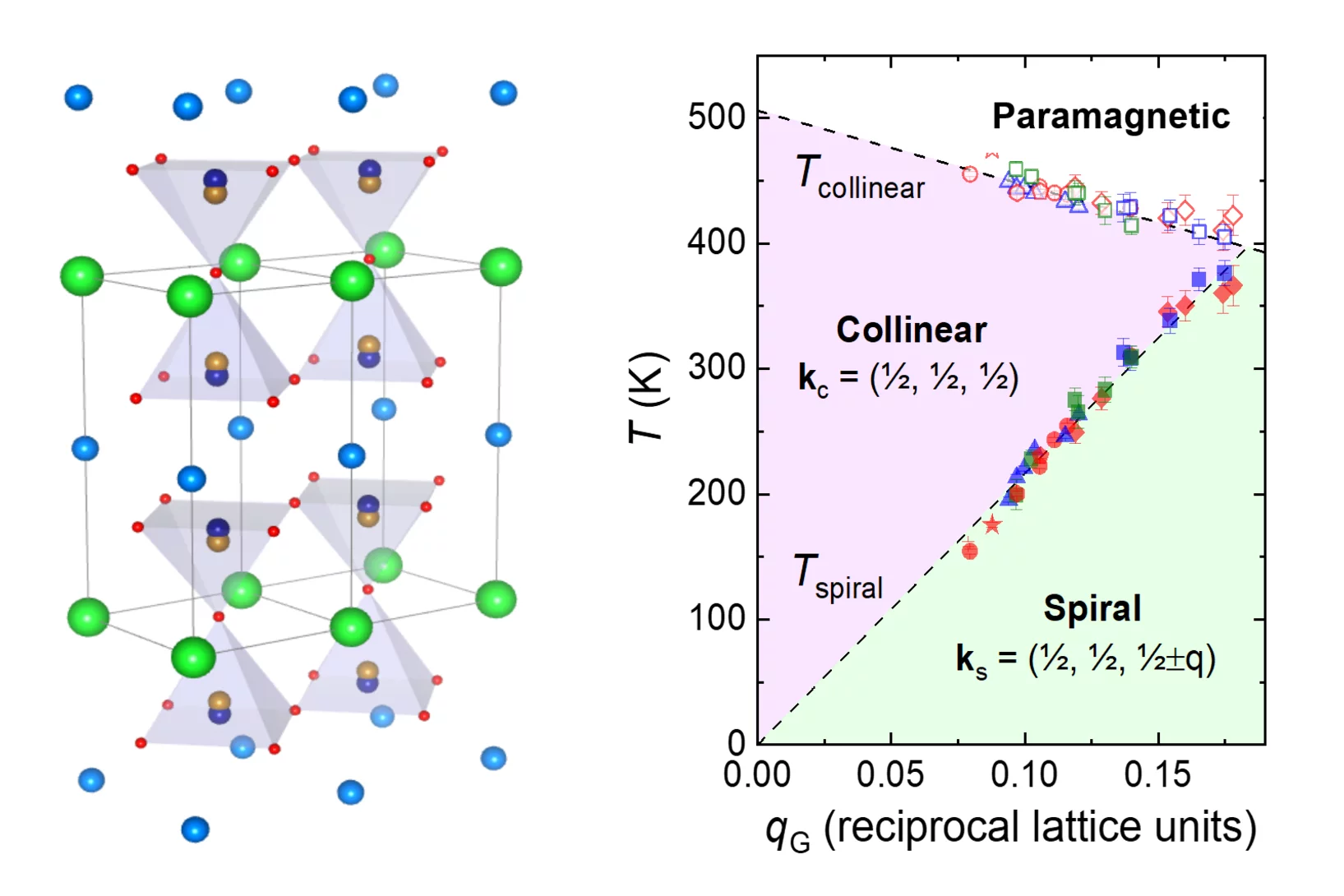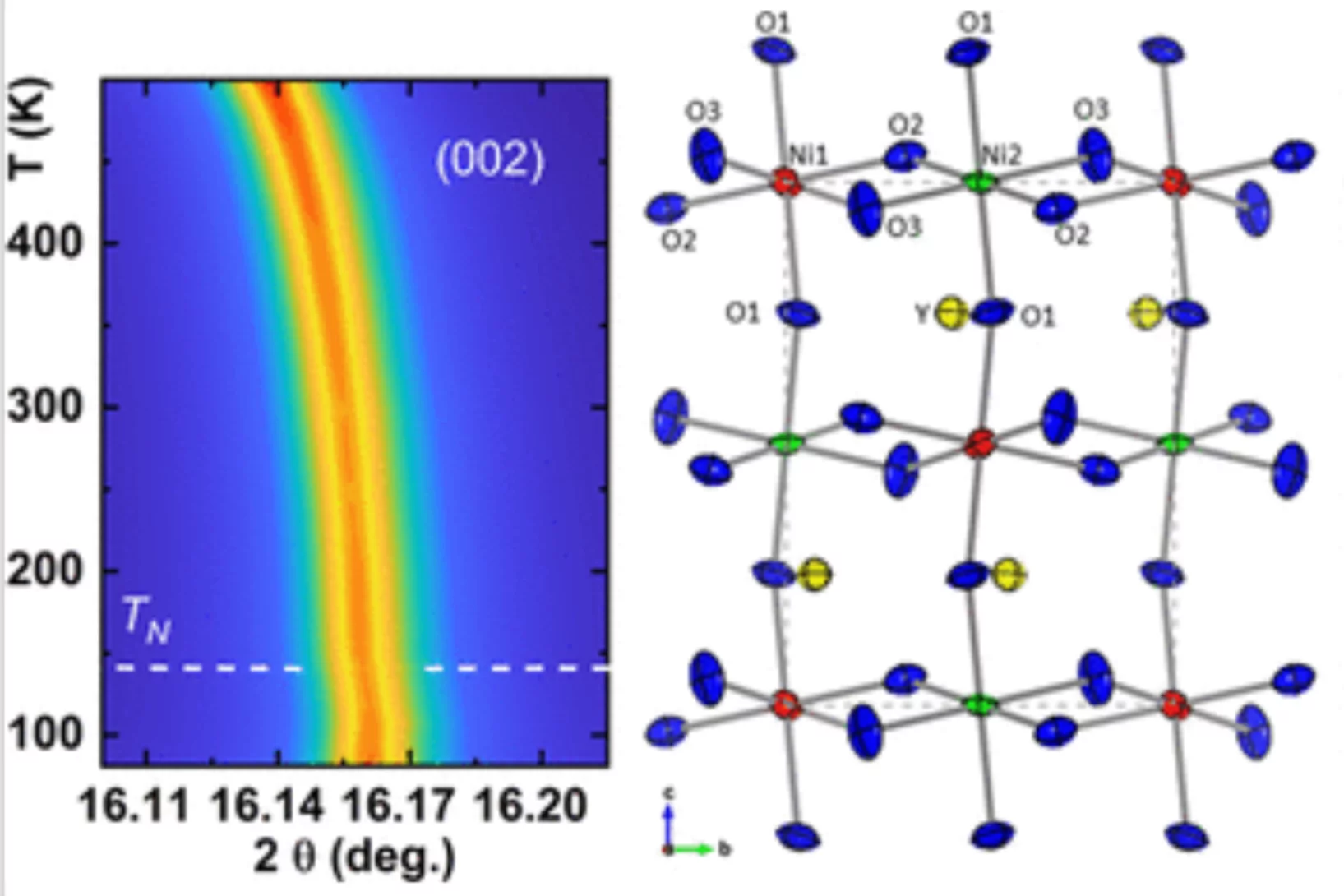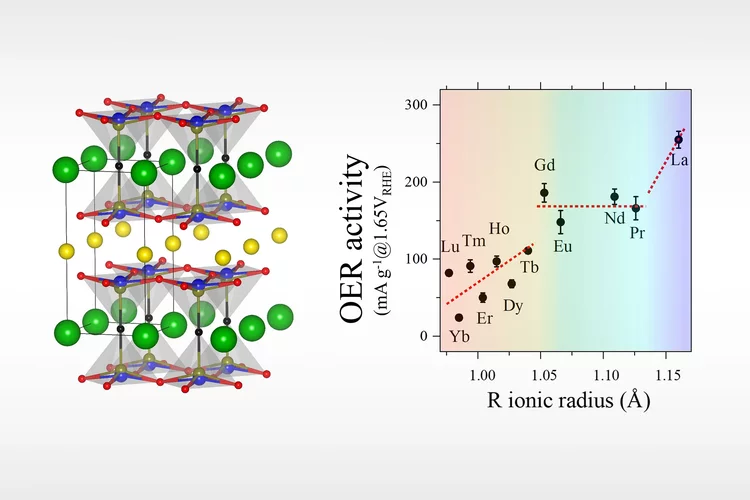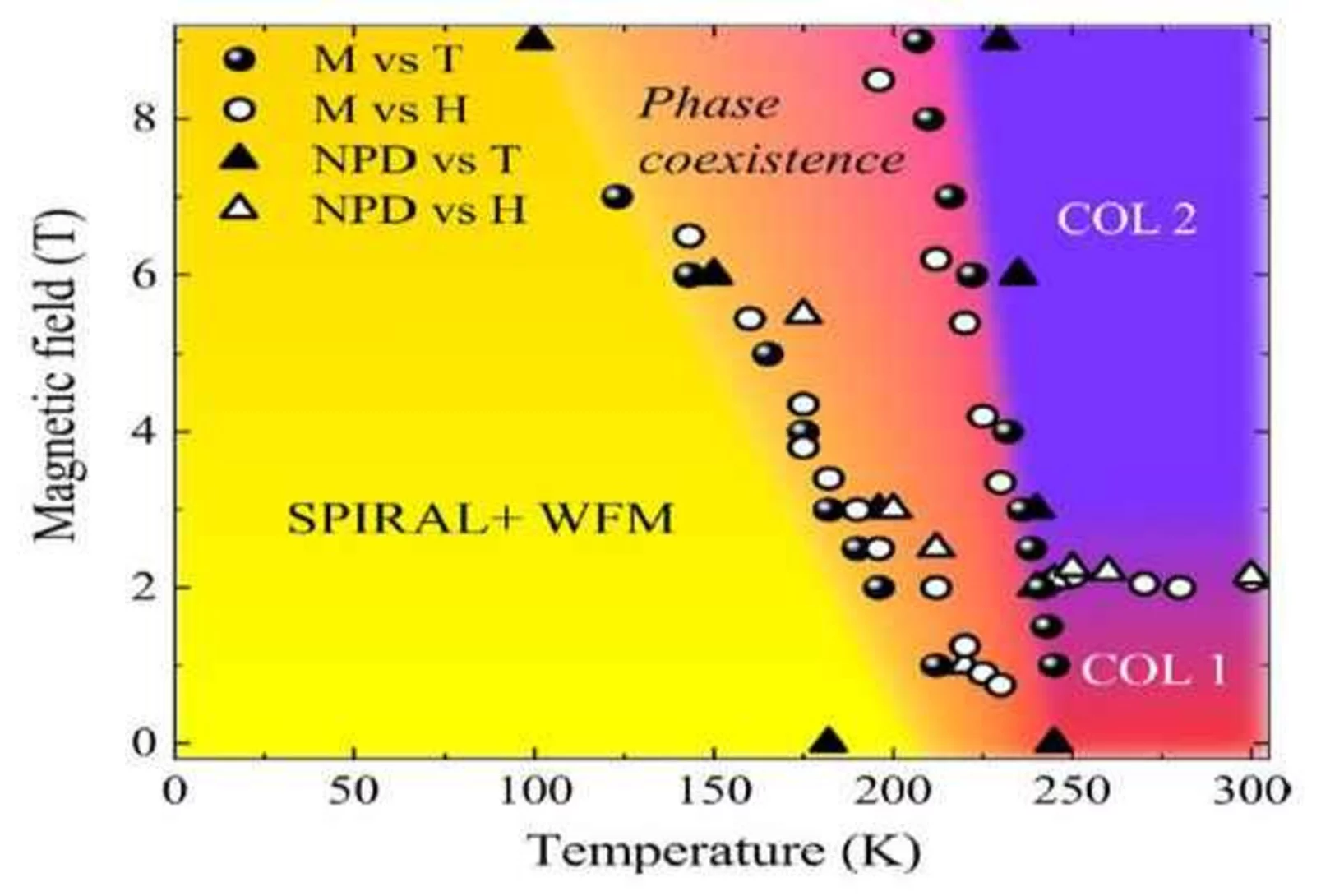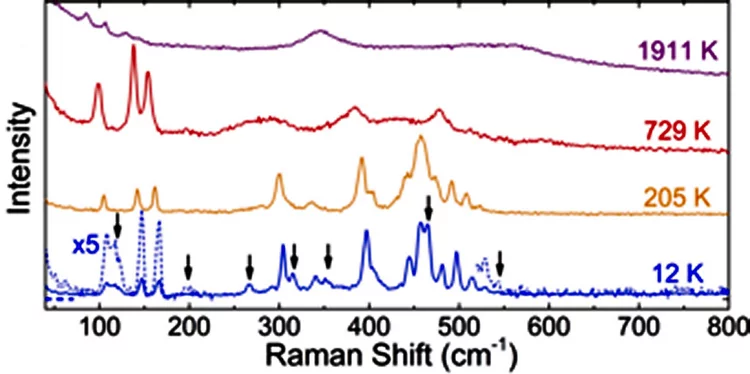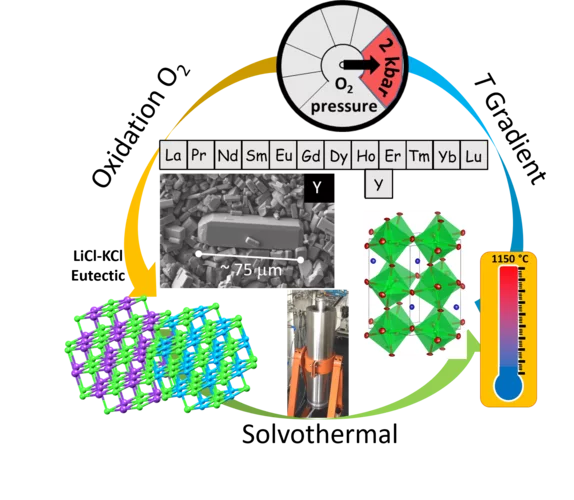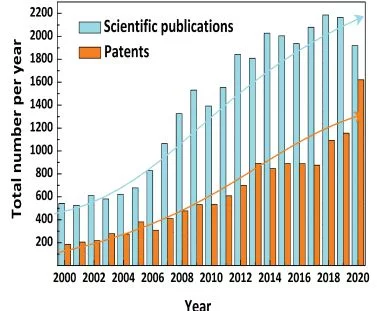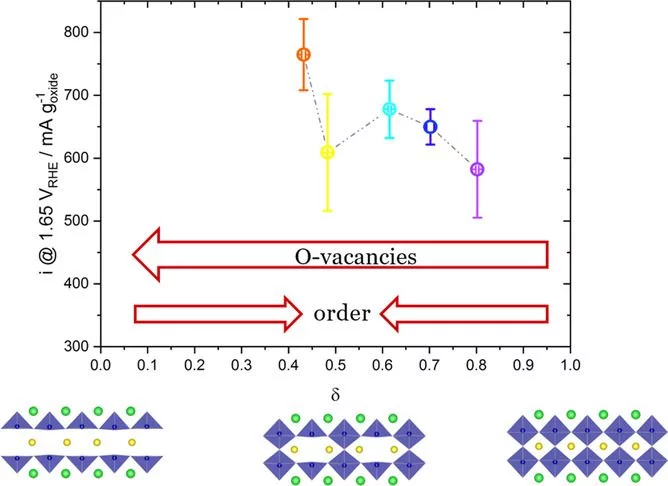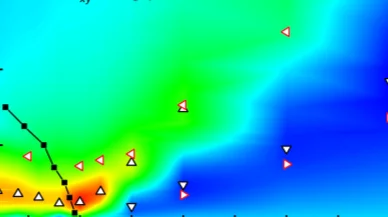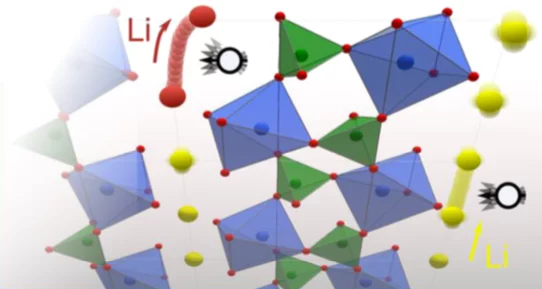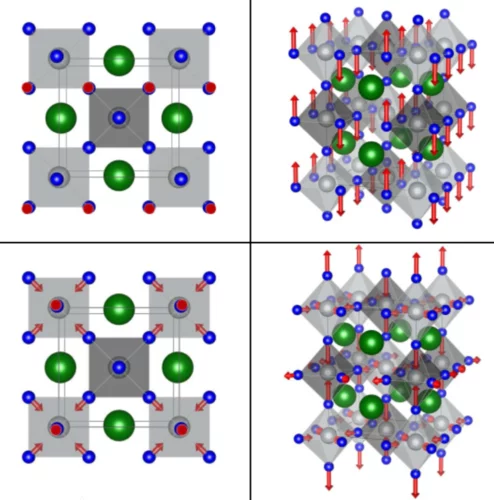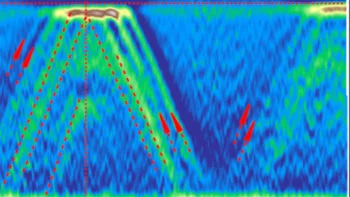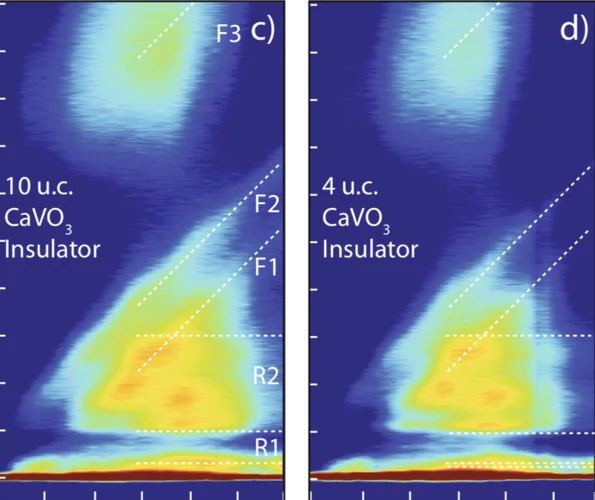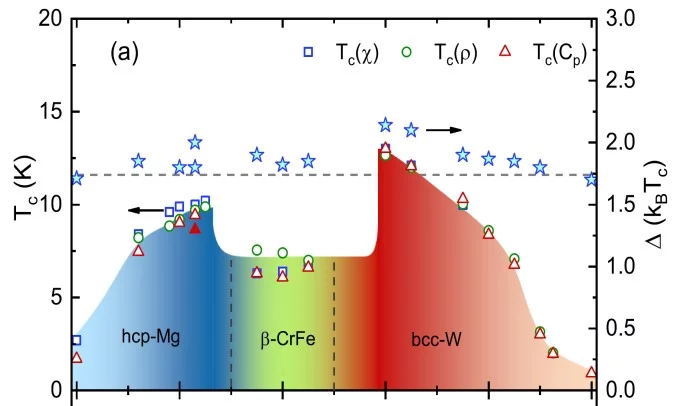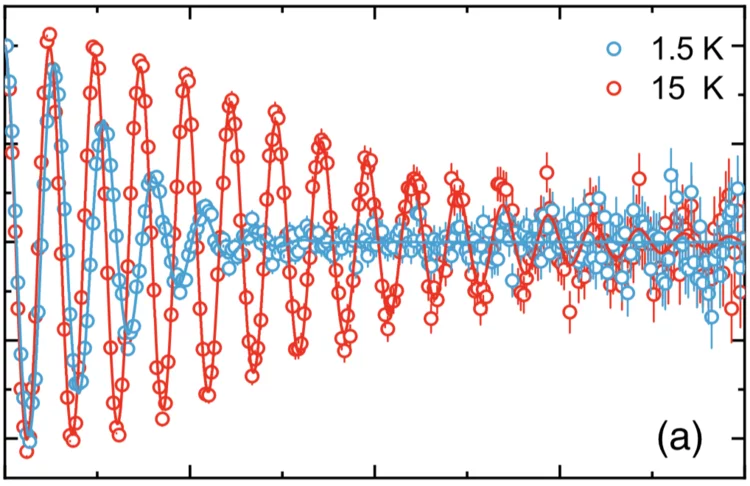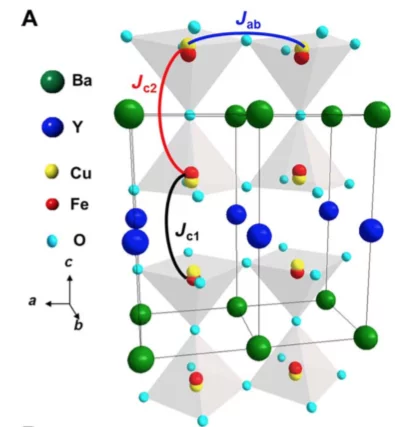YBa1−𝑥Sr𝑥CuFeO5 layered perovskites: An attempt to explore the magnetic order beyond the paramagnetic-collinear-spiral triple point
Layered perovskites of general formula AA'CuFeO5 are characterized by the presence of spiral magnetic phases whose ordering temperatures 𝑇spiral can be tuned far beyond room temperature by introducing modest amounts of Cu/Fe chemical disorder in the crystal structure. This rare property makes these materials prominent candidates to host multiferroicity and magnetoelectric coupling at temperatures suitable for applications. Moreover, it has been proposed that the highest 𝑇spiral value that can be reached in this structural family ( ∼400 K) corresponds to a paramagnetic-collinear-spiral triple point with potential to show exotic physics. Since generating high amounts of Cu/Fe disorder is experimentally difficult, the phase diagram region beyond the triple point has been barely explored. To fill this gap we investigate here eleven YBa1−𝑥Sr𝑥CuFeO5 solid solutions (0≤𝑥≤1 ), where we replace Ba with Sr with the aim of enhancing the impact of the experimentally available Cu/Fe disorder. Using a combination of bulk magnetization measurements, synchrotron x-ray and neutron powder diffraction we show that the spiral state with 𝐤𝑠=(1/2,1/2,1/2±𝑞) is destabilized beyond a critical Sr content, being replaced by a fully antiferromagnetic state with ordering temperature 𝑇coll2≥𝑇spiral and propagation vector 𝐤𝑐2=(1/2,1/2,0). Interestingly, both 𝑇spiral and 𝑇coll2 increase with 𝑥 with comparable rates. This suggests a common, disorder-driven origin for both magnetic phases, consistent with theoretical predictions.
Room temperature magnetoelectric magnetic spirals by design
Frustrated magnets with ordered magnetic spiral phases that spontaneously break inversion symmetry have received significant attention from both fundamental and applied sciences communities due to the experimental demonstration that some of these materials can couple to the lattice and induce electric polarization. In these materials, the common origin of the electric and magnetic orders guarantees substantial coupling between them, which is highly desirable for applications ...
Magnetostructural Coupling at the Néel Point in YNiO3 Single Crystals
The recent discovery of superconductivity in infinite layer thin films and bulk Ruddlesden–Popper nickelates has stimulated the investigation of other predicted properties of these materials. Among them, the existence of magnetism-driven ferroelectricity in the parent compounds RNiO3 (R = 4f lanthanide and Y) at the onset of the Néel order, TN, has remained particularly elusive. Using diffraction techniques, we reveal here the existence of magnetostriction at TN in bulk YNiO3 single crystals. Interestingly, the associated lattice anomalies ...
Cobalt-free layered perovskites RBaCuFeO5+d (R = 4f lanthanide) as electrocatalysts for the oxygen evolution reaction
Co oxides with perovskite-related structure are particularly promising, cost-effective OER catalysts. However, the increasing Co demand by the battery industry is pushing the search for Co-free alternatives. Here we investigate the potential of the Co-free layered perovskite family RBaCuFeO5+δ (R = 4f lanthanide), where we identify the critical structural and electronic variables leading to high OER catalytical performance. The employed methodology, based in the use of advanced neutron and X-ray synchrotron techniques combined with ab initio DFT calculations allowed to reveal LaBaCuFeO5+δ as new, promising Co-free electroctalyst. Moreover, we could show that this material can be industrially produced in nanocrystalline form. We believe that the reported results and methodology may contribute to the implementation of new technologies aimed to generate energy with lower carbon emissions, and can also inspire the scientific community in their search of other Co-free materials with good OER electrocatalytical properties.
Weak ferromagnetism linked to the high-temperature spiral phase of YBaCuFeO5
The layered perovskite YBaCuFeO5 is a rare example of a cycloidal spiral magnet whose ordering temperature Tspiral can be tuned far beyond room temperature by adjusting the degree of Cu2+/ Fe3+ chemical disorder in the structure. This unusual property qualifies this material as one of the most promising spin-driven multiferroic candidates. However, very little is known about the response of the spiral to magnetic fields, crucial for magnetoelectric cross-control applications. Using bulk magnetization and neutron powder diffraction measurements under magnetic fields up to 9 T, we report here a temperature-magnetic field phase diagram of this material. Besides revealing a strong stability of the spiral state, our data uncover the presence of weak ferromagnetism coexisting with the spiral modulation. Since ferromagnets can be easily manipulated with magnetic fields, this observation opens new perspectives for the control of the spiral orientation, directly linked to the polarization direction, as well as for a possible future use of this material in technological applications.
Raman spectroscopic evidence for multiferroicity in rare earth nickelate single crystals
The rare earth nickelates RNiO3 are metallic at high temperatures and insulating and magnetically ordered at low temperatures. The low temperature phase has been predicted to be type II multiferroic, i.e., ferroelectric and magnetic order are coupled and occur simultaneously. Confirmation of those ideas has been inhibited by the absence of experimental data on single crystals. Here we report on Raman spectroscopic data of RNiO3 single crystals (R = Y, Er, Ho, Dy, Sm, Nd) for temperatures between 10 and 1000 K. Entering the magnetically ordered phase we observe the appearance of a large number of additional vibrational modes, implying a breaking of inversion symmetry expected for multiferroic order.
RENiO3 Single Crystals (RE = Nd, Sm, Gd, Dy, Y, Ho, Er, Lu) Grown from Molten Salts under 2000 bar of Oxygen Gas Pressure
The electronic properties of transition-metal oxides with highly correlated electrons are of central importance in modern condensed-matter physics and chemistry, both for their fundamental scientific interest and for their potential for advanced electronic applications. However, the design of materials with tailored properties has been restricted by the limited understanding of their structure–property relationships, which are particularly complex in the proximity of the regime where localized electrons become gradually mobile. RENiO3 perovskites, characterized by the presence of spontaneous metal to insulator transitions, are some of the most widely used model materials for the investigation of this region in theoretical studies. However, crucial experimental information needed to validate theoretical predictions is still lacking due to their challenging high-pressure synthesis, which has prevented to date the growth of sizable bulk single crystals with RE ≠ La, Pr, and Nd. Here we report the first successful growth of single crystals with RE = Nd, Sm, Gd, Dy, Y, Ho, Er, and Lu in sizes up to ∼75 μm, grown from molten salts in a temperature gradient under 2000 bar of oxygen gas pressure. The crystals display regular prismatic shapes with flat facets, and their crystal structures and metal–insulator and antiferromagnetic order transition temperatures are in excellent agreement with previously reported values obtained from polycrystalline samples. The availability of such crystals opens access to measurements that have hitherto been impossible to conduct. This should contribute to a better understanding of the fascinating properties of materials with highly correlated electrons and guide future efforts to engineer transition-metal oxides with tailored functional properties.
Roadmap on Magnetoelectric Materials and Devices
The possibility of tuning the magnetic properties of materials with voltage (converse magnetoelectricity) or generating electric voltage with magnetic fields (direct magnetoelectricity) has opened new avenues in a large variety of technological fields, ranging from information technologies to healthcare devices and including a great number of multifunctional integrated systems, such as mechanical antennas, magnetometers, and radio frequency (RF) tunable inductors, which have been realized due to the strong strain-mediated magnetoelectric (ME) coupling found in ME composites. The development of single-phase multiferroic materials (which exhibit simultaneous ferroelectric and ferromagnetic or antiferromagnetic orders), multiferroic heterostructures, as well as progress in other ME mechanisms, such as electrostatic surface charging or magneto-ionics (voltage-driven ion migration), have a large potential to boost energy efficiency in spintronics and magnetic actuators. This article focuses on existing ME materials and devices and reviews the state of the art in their performance.
Correlation between Oxygen Vacancies and Oxygen Evolution Reaction Activity for a Model Electrode: PrBaCo2O5+δ
The role of the perovskite lattice oxygen in the oxygen evolution reaction (OER) is systematically studied in the PrBaCo2O5+δ family. The reduced number of physical/chemical variables combined with in-depth characterizations such as neutron dif-fraction, O K-edge X-ray absorption spectroscopy (XAS), electron energy loss spectroscopy (EELS), magnetization and scanning transmission electron microscopy (STEM) studies, helps investigating the complex correlation between OER activity and a single perovskite property, such as the oxygen content. Larger amount of oxygen vacancies appears to facilitate the OER, possibly contributing to the mechanism involving the oxidation of lattice oxygen, i.e., the lattice oxygen evolution reaction (LOER). Furthermore, not only the number of vacancies but also their local arrangement in the perovskite lattice influences the OER activity, with a clear drop for the more stable, ordered stoichiometry.
Unconventional Transverse Transport above and below the Magnetic Transition Temperature in Weyl Semimetal EuCd2As2
As exemplified by the growing interest in the quantum anomalous Hall effect, the research on topology as an organizing principle of quantum matter is greatly enriched from the interplay with magnetism. In this vein, we present a combined electrical and thermoelectrical transport study on the magnetic Weyl semimetal EuCd2As2. Unconventional contribution to the anomalous Hall and anomalous Nernst effects were observed both above and below the magnetic transition temperature of EuCd2As2, indicating the existence of significant Berry curvature.
Quantifying Diffusion through Interfaces of Lithium-Ion Battery Active Materials
Detailed understanding of charge diffusion processes in a lithium-ion battery is crucial to enable its systematic improvement. Experimental investigation of diffusion at the interface between active particles and the electrolyte is challenging but warrants investigation as it can introduce resistances that, for example, limit the charge and discharge rates. Here, we show an approach to study diffusion at interfaces using muon spin spectroscopy.
Distortion mode anomalies in bulk PrNiO3: Illustrating the potential of symmetry-adapted distortion mode analysis for the study of phase transitions
The origin of the metal-to-insulator transition (MIT) in RNiO3 perovskites with R = trivalent 4f ion has challenged the condensed matter research community for almost three decades. A drawback for progress in this direction has been the lack of studies combining physical properties and accurate structural data covering the full nickelate phase diagram. Here we focus on a small region close to the itinerant limit (R = Pr, 1.5K < T < 300K), where we investigate the gap opening and the simultaneous emergence of charge order in PrNiO3.
Spin fluctuation induced Weyl semimetal state in the paramagnetic phase of EuCd2As2
Weyl fermions as emergent quasiparticles can arise in Weyl semimetals (WSMs) in which the energy bands are nondegenerate, resulting from inversion or time-reversal symmetry breaking. Nevertheless, experimental evidence for magnetically induced WSMs is scarce. Here, using photoemission spectroscopy, we observe that the degeneracy of Bloch bands is already lifted in the paramagnetic phase of EuCd2As2. We attribute this effect to the itinerant electrons experiencing quasi-static and quasi–long-range ferromagnetic fluctuations.
Electronic localization in CaVO3 films via bandwidth control
Understanding and controlling the electronic structure of thin layers of quantum materials is a crucial first step towards designing heterostructures where new phases and phenomena, including the metal-insulator transition (MIT), emerge. Here, we demonstrate control of the MIT via tuning electronic bandwidth and local site environment through selection of the number of atomic layers deposited.
Structure and superconductivity in the binary Re1-xMox alloys
The binary Re1−xMox alloys, known to cover the full range of solid solutions, were successfully synthesized and their crystal structures and physical properties investigated via powder x-ray diffraction, electrical resistivity, magnetic susceptibility, and heat capacity. By varying the Re/Mo ratio, we explore the full Re1−xMox binary phase diagram, in all its four different solid phases: hcp-Mg (P63/mmc), α-Mn (I43m), β-CrFe (P42/mnm), and bcc-W (Im3m), of which the second is non-centrosymmetric with the rest being centrosymmetric. All Re1−xMox alloys are superconductors, whose critical temperatures exhibit a peculiar phase diagram, characterized by three different superconducting regions.
Time-Reversal Symmetry Breaking in Re-Based Superconductors
To trace the origin of time-reversal symmetry breaking (TRSB) in Re-based superconductors, we performed comparative muon-spin rotation and relaxation (μSR) studies of superconducting noncentro-symmetric Re0.82Nb0.18 (Tc=8.8 K) and centrosymmetric Re (Tc=2.7 K).
Design of magnetic spirals in layered perovskites: Extending the stability range far beyond room temperature
In insulating materials with ordered magnetic spiral phases, ferroelectricity can emerge owing to the breaking of in- version symmetry. This property is of both fundamental and practical interest, particularly with a view to exploiting it in low-power electronic devices. Advances toward technological applications have been hindered, however, by the rel- atively low ordering temperatures Tspiral of most magnetic spiral phases, which rarely exceed 100 K.
New magnetic phase in the nickelate perovskite TlNiO3
The RNiO3 perovskites are known to order antiferromagnetically below a material-dependent Néel temperature TN. We report experimental evidence indicating the existence of a second magnetically ordered phase in TlNiO3 above TN = 104K, obtained using nuclear magnetic resonance and muon spin rotation spectroscopy.


